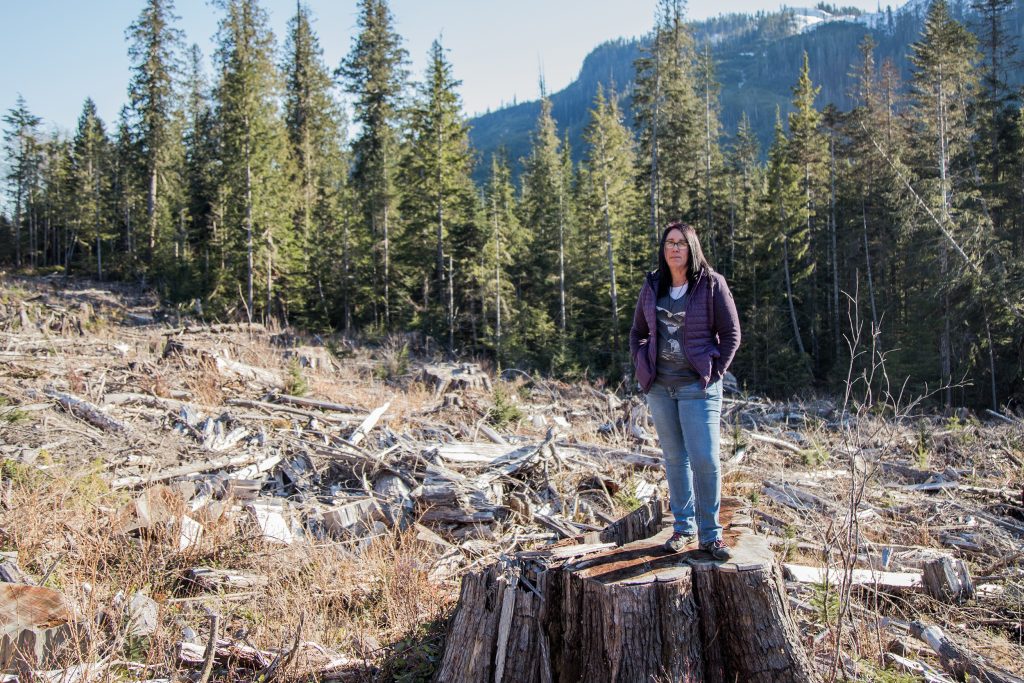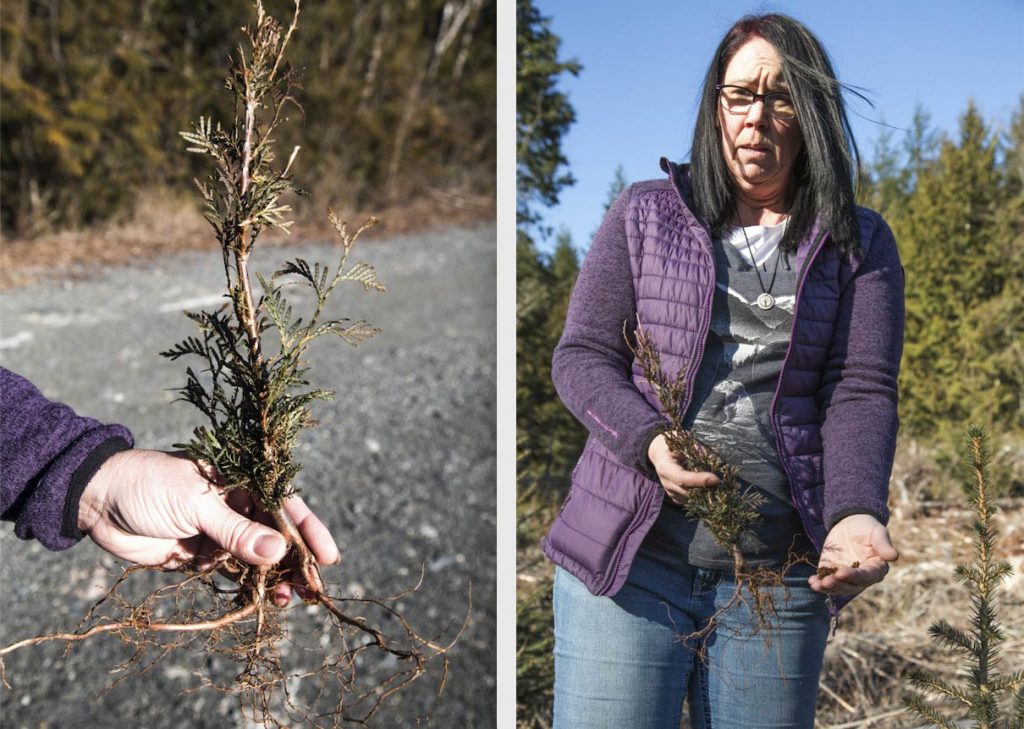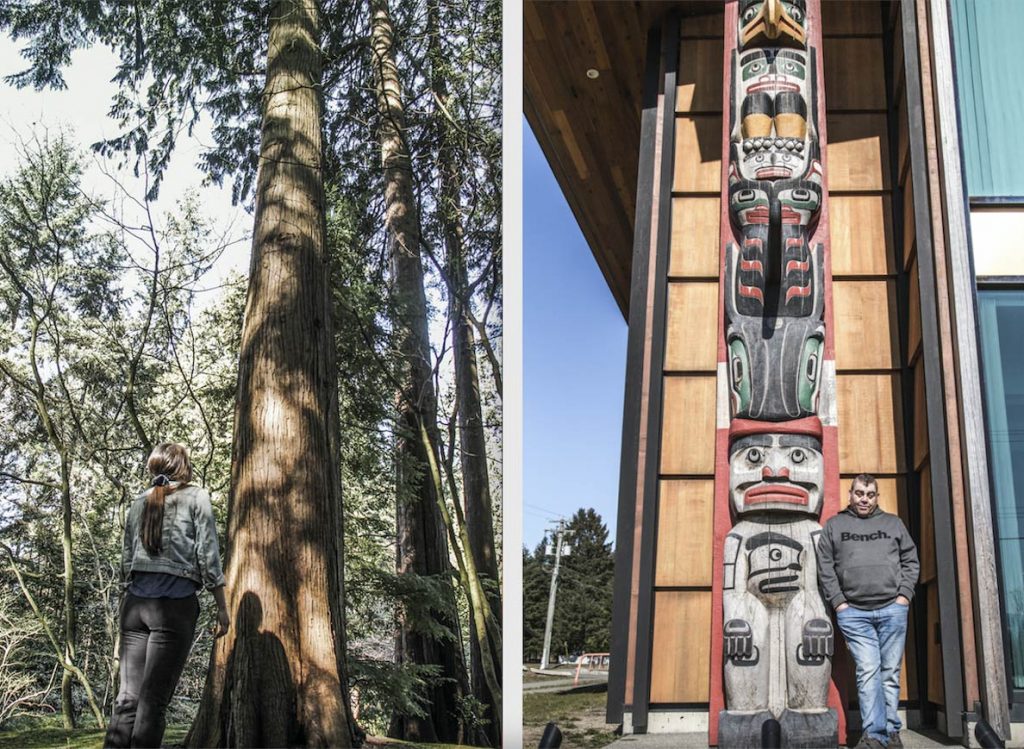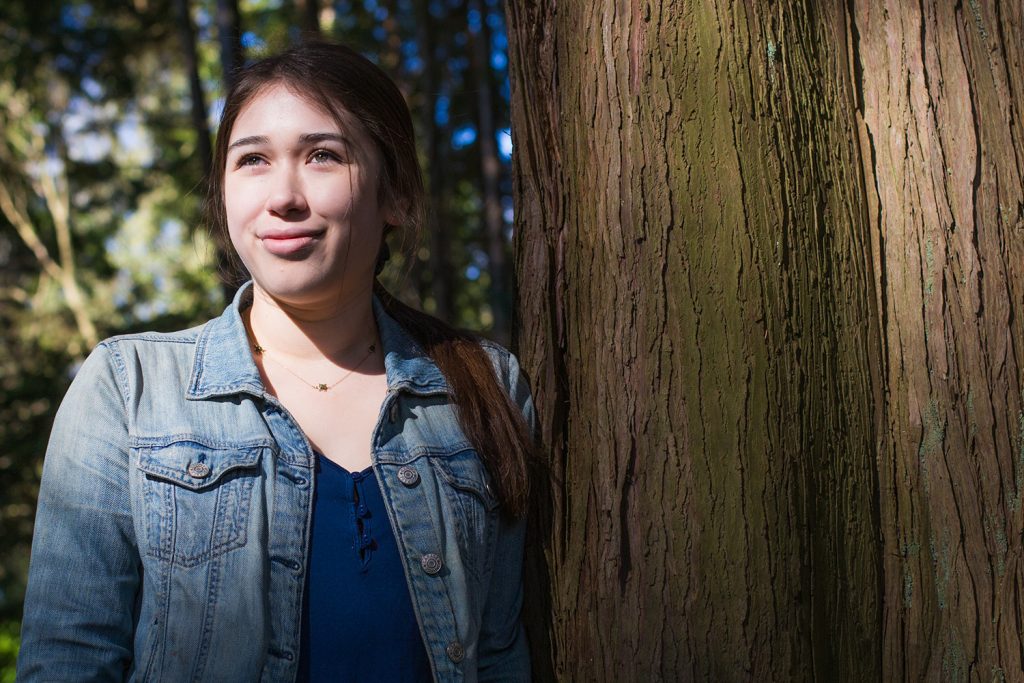
By Serena Renner and Ayesha Ghaffar
An hour northwest of Campbell River, on Vancouver Island, Gina Thomas climbs a giant tree stump. Its diameter is at least five feet wide. The bark bears wavy vertical lines indicating this was once a western red cedar.
A row of old-growth cedar towers in the background. But all around Thomas is a wasteland of wood chips, branches, and stumps.
This site was logged a few years back. The only green in the cutblock is the tiny saplings sprouting from debris.
“The trees they’re planting are Douglas fir,” said Thomas, who runs the local Guardian Watchmen program and has two decades of forestry experience. “These sites are getting too dry for cedar. That means we’re not getting any cedar regenerating here.”
Thomas is from Tlowitsis First Nation. In her culture — like in many coastal First Nations throughout British Columbia — western red cedar is known as “the tree of life.” For thousands of years it’s been used to make homes, clothing, canoes, masks, poles, and much more.
But here, in northeastern Vancouver Island, the tree of life is dying.
Leaves are turning brown. Saplings aren’t making it past their first years. Alarm within leadership has prompted local First Nations to create new policies to protect cedar for future generations.

‘Cedar trees are going from one extreme to the next’
The plight of cedar is a concern among scientists too. Research is underway to confirm what community members are seeing: western red cedar is not getting enough water during the summer growing season.
“Last summer, there was not enough rain, and now you’re seeing the effects,” Thomas said.
Eighty per cent of the island’s old-growth forest has already been logged. Western red cedar has long been a target for its beauty and versatility. Its soft fibre is even being used to make medical masks and gowns for protecting against COVID-19.
But younger trees are struggling to survive in a warmer climate with less forest canopy. It’s a vicious cycle since old-growth forests are good at sequestering carbon, and creating the cool, moist conditions that cedar needs.
Randy Frank, a master carver and Guardian Watchman from K’òmoks First Nation, has a deep connection with cedar. He transforms the wood into masks and totem poles, and named one of his sons after the tree. Now, he’s monitoring the health of cedars as they experience increased heat and floods.
“Cedar trees are going from one extreme to the next,” Frank said. “We’re finding trees in open cutblocks drying up and dying. With the hot summers here, it’s almost like the branches of the cedar trees are burning.”

New policies for protection
Local chiefs such as Thomas’s uncle Chief John Smith started noticing the lack of “large cultural cedars” — the massive ones suitable for making canoes, house posts, and poles — about 20 years ago.
More recently, he helped initiate the Large Cultural Cedar Project to survey large cedars accessible in the territory, which extends from northern Vancouver Island to the mainland.
The program, managed by Nanwakolas Council, an association of five member nations, has identified several hundred large cedars for protection.
Growing awareness about climate change has added urgency to the project, says Nanwakolas Council president Dallas Smith. The council is drafting new policies to make certain stands of old-growth cedar off-limits for harvesting.
The goal is to make more large cedar available to communities, and preserve enough old-growth to nurture the next generation of trees, like parents caring for their young.
“Some of these trees have to be left behind to help the new ones grow,” Smith says.
Additional measures will increase habitat protection around old-growth and conserve second-growth trees chosen for “recruitment.” These trees are designated to become future large cultural cedar, or in Thomas’s words “kids becoming adults”.
The council hopes the new protocols will be in effect by summer.

Beyond environmental and cultural reasons, cedar trees are vital for economic survival in First Nations, whether they’re used for local construction or carved into valuable works of art.
“We take the trees out of this equation and there’s a ripple effect we can’t keep up with,” Smith said. “If our forests become poor, like our communities, we’re going to hit a point of no return.”
Combining forestry practices
Gina Thomas thinks sustainable forest management is key. She’s instilled this belief in her daughter Alexandra, who’s studying forestry at UBC, just like Thomas did many years ago.
Once she gets her forestry license, Alexandra said she wants to buy a small plot of land to manage with her mom.

She imagines a working forest that combines Indigenous and western practices. Think strip barking, the careful harvest of cedar bark for weaving, as well as silviculture, a modern strategy for controlling the growth, composition, and ecological function of trees.
“Cedar stripping doesn’t have any long-term negative effects once the tree heals,” she explained. “Our people only took exactly what they needed and nothing else.”
The Thomas forest would follow this ethos, allowing for selective harvesting that prioritizes the community. Fewer cedar trees would be cut down, and the ones that are would be worth more.
“We can do things differently, instead of clear-cut everything, replant, harvest in 80 years,” Alexandra said. “We’re realizing we don’t have the trees to do that anymore. We don’t have the time to do that anymore.”
Serena Renner is a California-bred journalist and editor who likes to write about culture, social justice, and the environment as well as creative changemakers. She occasionally tweets @serena_renner and grams at @wanderwide.
Born and raised in Pakistan, Ayesha Ghaffar is adjusting to the 180-degree lifestyle shift after moving to Canada. A passionate writer and a good listener, follow her on Twitter @ayeshaghaffar

